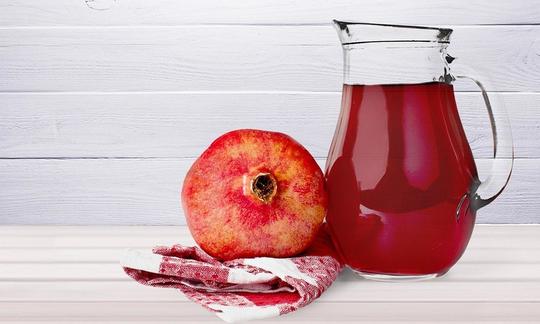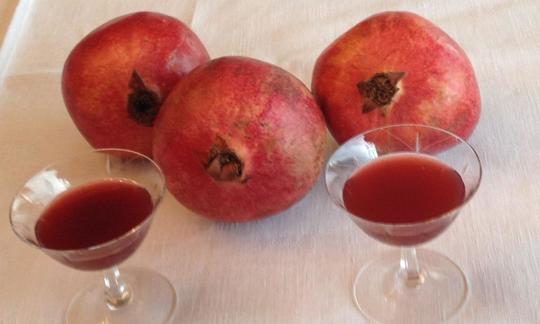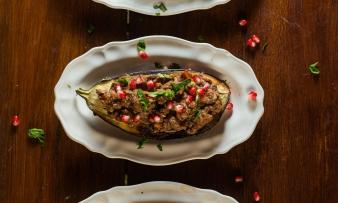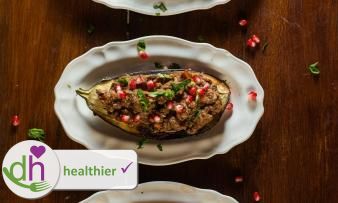Table of contents
Classic pomegranate syrup is a sugar -sweetened fruit syrup made from pomegranates ( Punica granatum) that is used to flavor and color cocktails and desserts, among other things. The syrup is also available in organic quality.
Use in the kitchen
Classic pomegranate syrup is an alcohol-free, intensely red syrup that is made from the juice of pomegranates, sugar and without the addition of any ingredients that alter the taste. Due to the production of the syrup and the associated heating, pomegranate syrup is not considered raw food. It should not be confused with grenadine syrup - often simply called grenadine. What is grenadine made of? Nowadays, grenadine syrup is often a mixture of different berries, with pomegranate juice only being present in small quantities or not at all. Grenadine syrup also often contains fruit flavors, vanilla, coloring, anthocyanins and preservatives.
The taste of pomegranate syrup is sweet, fruity and pleasantly sour with a subtle bitter note. What is pomegranate syrup used for? It is typically used as a coloring and flavoring agent in soft drinks and alcoholic beverages such as the "Tequila Sunrise" cocktail. It also tastes wonderful in combination with ginger and rosemary in sparkling wine, champagne, gin or just in table water. The syrup also makes a refreshing, summery spritzer.
The classic pomegranate syrup is also used in sweets and desserts. It is a delicious topping for ice cream and pancakes and refines many chocolate desserts such as cakes or mousse. The syrup can also be used for savory dishes. It is excellent in fruity salad dressings, vegan barbecue sauces, hummus and other dips. Vegan dishes with pomegranate syrup are particularly popular in oriental countries, such as pilaf (rice dish), Çiğ Köfte (bulgur meatballs), kisir (bulgur salad) and fesendschān (stew with potatoes and walnuts).
your own
You can easily make pomegranate syrup. The following link will take you to our recipe: Classic pomegranate syrup with granulated sugar.
Vegan recipe for tomato salad with pomegranate syrup
Ingredients (for 2 people): 4 tomatoes, 1 red onion, ½ bunch of parsley, 50 g walnuts, 2 tbsp pomegranate syrup, 2 tbsp lemon juice, 1 tbsp rapeseed oil, 1 tsp chili flakes, some salt andpepper.
Preparation of Gavurdagi: For this Turkish tomato salad (Gavurdagi), wash and dice the tomatoes. Peel the red onion and also cut into medium-sized cubes. Rinse the parsley, shake dry and chop finely. Roughly chop the walnuts. For the dressing, mix the pomegranate syrup, lemon juice, rapeseed oil and chili flakes and season with salt and pepper. Put the tomatoes, onion, parsley and walnuts in a bowl, spread the dressing over them and mix well. Leave the vegan Gavurdagi salad in the fridge for about 15 minutes and then serve. You can enjoy it as a starter (mezze), for example.
Vegan recipes with pomegranate syrup can be found under the note: " Recipes that have the most of this ingredient ".
| Not only vegans or vegetarians should read this: Vegans often eat unhealthily. Avoidable nutritional errors. |
Purchasing - Storage
Ready-made pomegranate syrup can be found in well-stocked branches of some supermarkets (e.g. Migros, Spar, Rewe) or beverage stores. Other supermarkets (e.g. Coop, Migros, Denner, Volg, Spar, Aldi, Lidl, Rewe, Edeka, Billa, Hofer) and organic supermarkets ( Alnatura, Denn's Biomarkt) sometimes only offer pomegranate juice. Pomegranate syrup can also often be bought in Turkish grocery stores or online shops. When buying grenadine syrup, you should keep an eye on the ingredients, especially the actual proportion of pomegranates.
You can find out where to find whole pomegranates in the corresponding ingredient " Pomegranate (grenadine, raw, organic?) ".
The availability of pomegranate syrup varies depending on the size of the store, catchment area, etc. If you are interested, click on our recorded food prices for the DA-CH countries (above under the ingredient image). There you will find current prices from various supermarkets and their price development.
Storage tips
Syrup should be stored at room temperature and, due to its sugar content, it generally has a very long shelf life. The higher the sugar content in the syrup, the longer it will last. Longer storage may result in loss of color and flavor, but the syrup can still be used without any problems. When storing, make sure that the syrup is hermetically sealed and does not come into contact with leftover food. You can tell that syrup has gone bad by mold or a fermenting smell.
Ingredients - Nutritional values - Calories
The energy content of pomegranate syrup is 122 kcal per 100 g. It contains 29 g of carbohydrates per 100 g, of which 25 g are sugar - slightly more than in date syrup (22 g/100g), but less than in maple syrup (60 g/100g), agave syrup (68 g/100g) and apple syrup (77 g/100g). The fat content is 1 g and the protein content is 3.5 g per 100 g. 1
100 g of pomegranate syrup contains 14 µg of vitamin K (19% of the daily requirement). Sweet soy sauce (14 µg/100g) and carrot juice (16 µg/100g) contain similar amounts. A fruit that contains significantly more of the vitamin is kiwi (40 µg/100g). 1
Classic pomegranate syrup also contains 33 µg of folate (folic acid) per 100 g (17% of the daily requirement). Agave syrup has a comparable content (30 µg/100g). Yeast extract (spice paste) contains an extremely high amount of folate at 3,786 µg/100g. 1
The vitamin C (ascorbic acid) content is 8.9 mg per 100 g (11% of the daily requirement). This is comparable to that of sauerkraut juice (8.2 mg/100g) and date syrup (6.7 mg/100g). Sea buckthorn berries contain 450 mg/100g, just over 50 times as much vitamin C. 1
Note: It should be noted that the content of vitamins and minerals is slightly reduced in contrast to the whole, raw pomegranate due to the heating during the production of the syrup.
The complete ingredients of pomegranate syrup, the coverage of the daily requirement and comparison values with other ingredients can be found in our nutrient tables. In the article Nutrients explained you will get a detailed insight into the topic.
Effects on health
Is pomegranate syrup healthy? There are countless studies on the positive effects of pomegranates on health. It is conceivable that classic pomegranate syrup, which consists of the juice of the pomegranate, has similar effects, but to a reduced extent due to the processing methods. Read about the health-promoting properties of the ingredient " pomegranate ".
However, there are a few studies on pomegranate syrup. For example, it has been shown that pomegranate syrup, along with peppermint syrup, lemon and ginger, can safely and effectively help relieve nausea and vomiting during pregnancy. 2
In Mediterranean countries, including Tunisia, mint syrup or pomegranate syrup is often added to green tea preparations. A Tunisian study examined the benefits of syrups as an additive to green tea and found that they stabilized the polyphenol content and biofunctional properties of the beverage during cold storage. 3
Dangers - Intolerances - Side effects
Pomegranate syrup, like other fruit syrups, contains a significant amount of sugar. Therefore, it should only be consumed in moderation.
Ecological footprint - animal welfare
The ecological CO2 footprint of pomegranate syrup is made up of the ingredients used, usually pomegranates and sugar, as well as the individual production steps. Fruits that do not visually meet market standards are also used to produce pomegranate syrup. This reduces unnecessary food waste (more information at Pomegranate).
Worldwide occurrence - cultivation
The pomegranate ( Punica granatum) originally comes from Iran and the surrounding regions. The plants are cultivated from the Middle East to northern India, but also in southern Europe, the USA and parts of Africa. The largest growing nations are Iran and India. 4.5
Possible confusion
Are pomegranate syrup and grenadine the same thing? As explained in the first chapter (Using pomegranate syrup in the kitchen), pomegranate syrup and grenadine syrup (grenadine) are not necessarily the same thing, as grenadine syrup does not necessarily have to consist of pomegranate juice, but often of a mixture of different berries.
According to some sources, there is also a difference between pomegranate molasses and pomegranate syrup. Pomegranate molasses is simply boiled down pomegranate juice, which gets its sweetness from the fruit sugar and therefore has no added sugar. In contrast, sugar is added to pomegranate syrup. 6 Other sources do not mention a difference between pomegranate syrup and pomegranate molasses, although pomegranate molasses can contain sugar and pomegranate syrup can be made without sugar.
Further information
The pomegranate ( Punica granatum) belongs to the loosestrife family (Lythraceae). The fruit was and is a symbol of health, fertility and rebirth and is mentioned in the Bible, the Koran and in Buddhist and Chinese teachings. 7
Alternative names
Other common names for pomegranate molasses are grenadine syrup and pomegranate molasses. Turkish pomegranate molasses is called Nar Eksisi.
In English it is called pomegranate syrup or pomegranate molasses.
Bibliography - 5 Sources
| 1. | USDA United States Department of Agriculture. |
| 2. | Khorasani F, Aryan H, Sobhi A, Aryan R, Abavi-Sani A, Ghazanfarpour M, u. a. A systematic review of the efficacy of alternative medicine in the treatment of nausea and vomiting of pregnancy. J Obstet Gynaecol. 2020;40(1):10-9. |
| 3. | Dhaouadi K, Belkhir M, Raboudi F, Mecha E, Ghommeme I, Bronze MDR, u. a. Pomegranate and mint syrup addition to green tea beverage stabilized its polyphenolic content and biofunctional potentials during refrigerated storage. J Food Sci Technol. 2016;53(2):1164-77. |
| 6. | Dhumal SS, Karale A, Jadhav S, Kad V. Recent advances and the developments in the pomegranate processing and utilization: A review. Journal of Agriculture and Crop Science. 2014;1(1):1-17. |
| 7. | Chandra R. Babu DK. Jadhav VT. Teixeira da Silva JA. Origin, History and Domestication of Pomegranate. Fruit, Vegetable and Cereal Science and Biotechnology. 2010;4(2):1-6. |













Comments